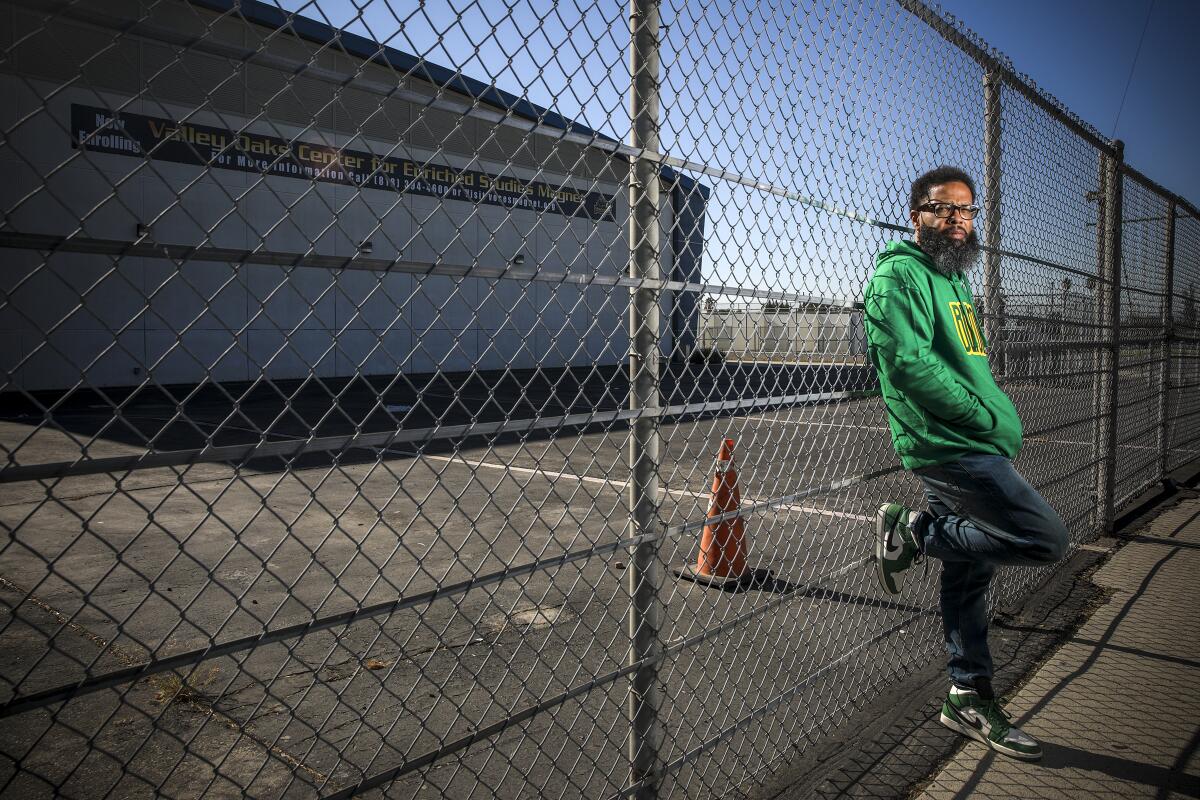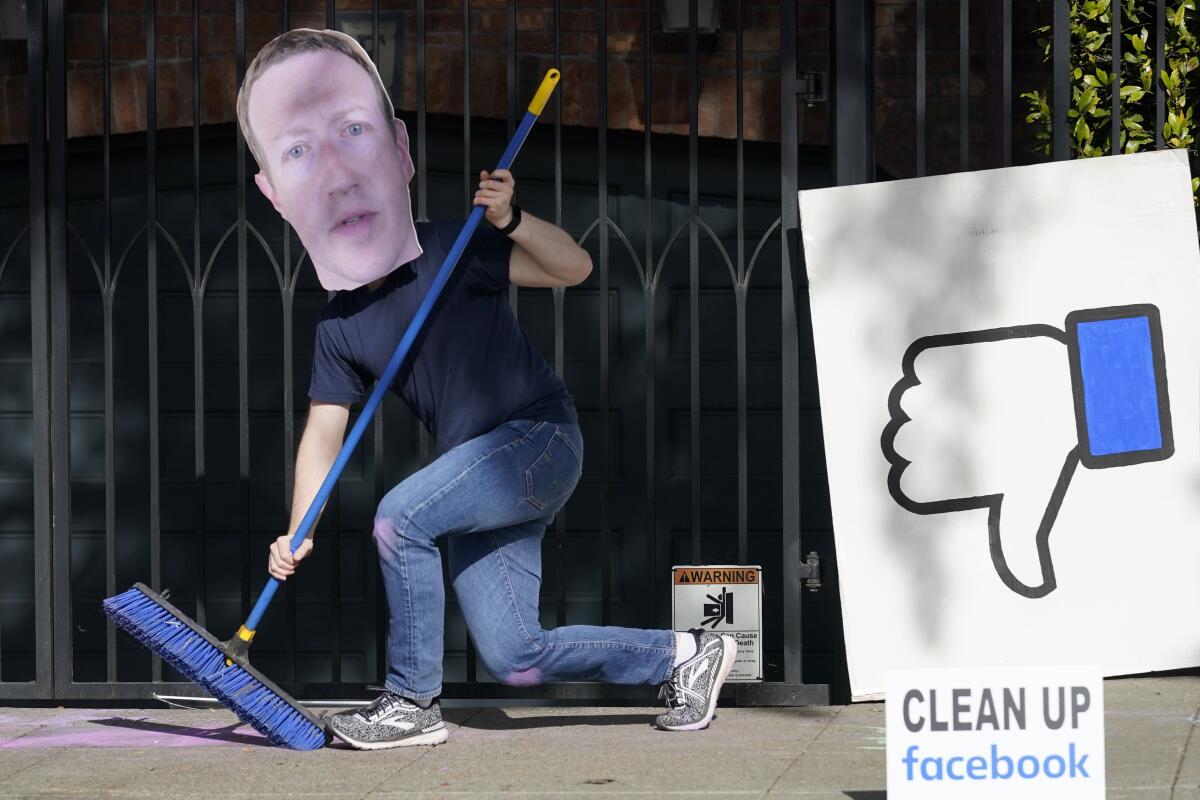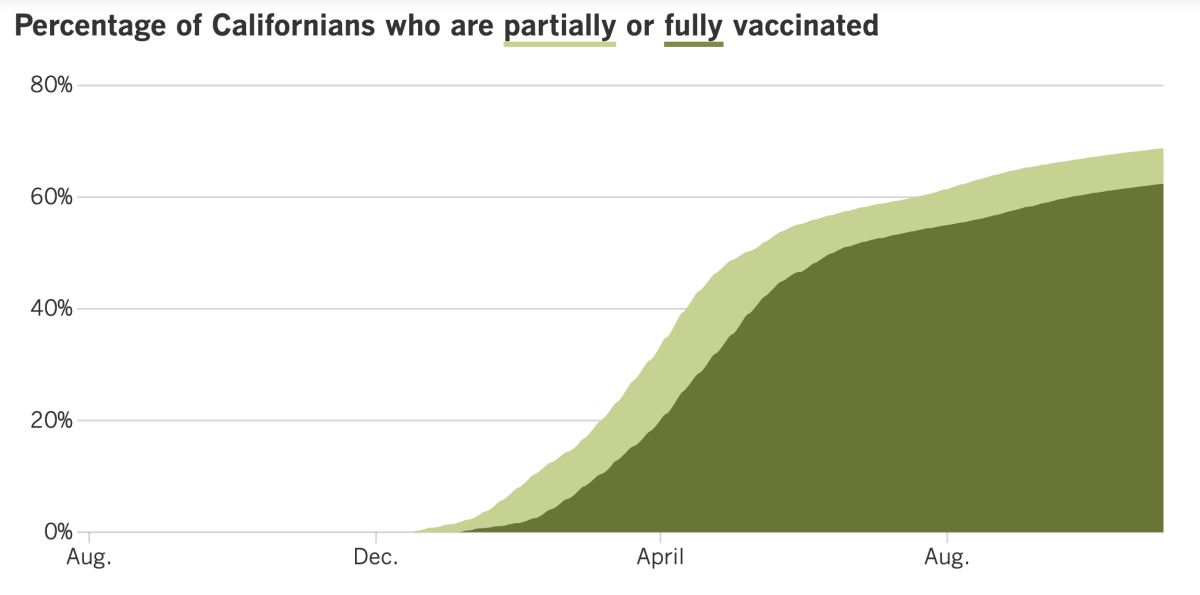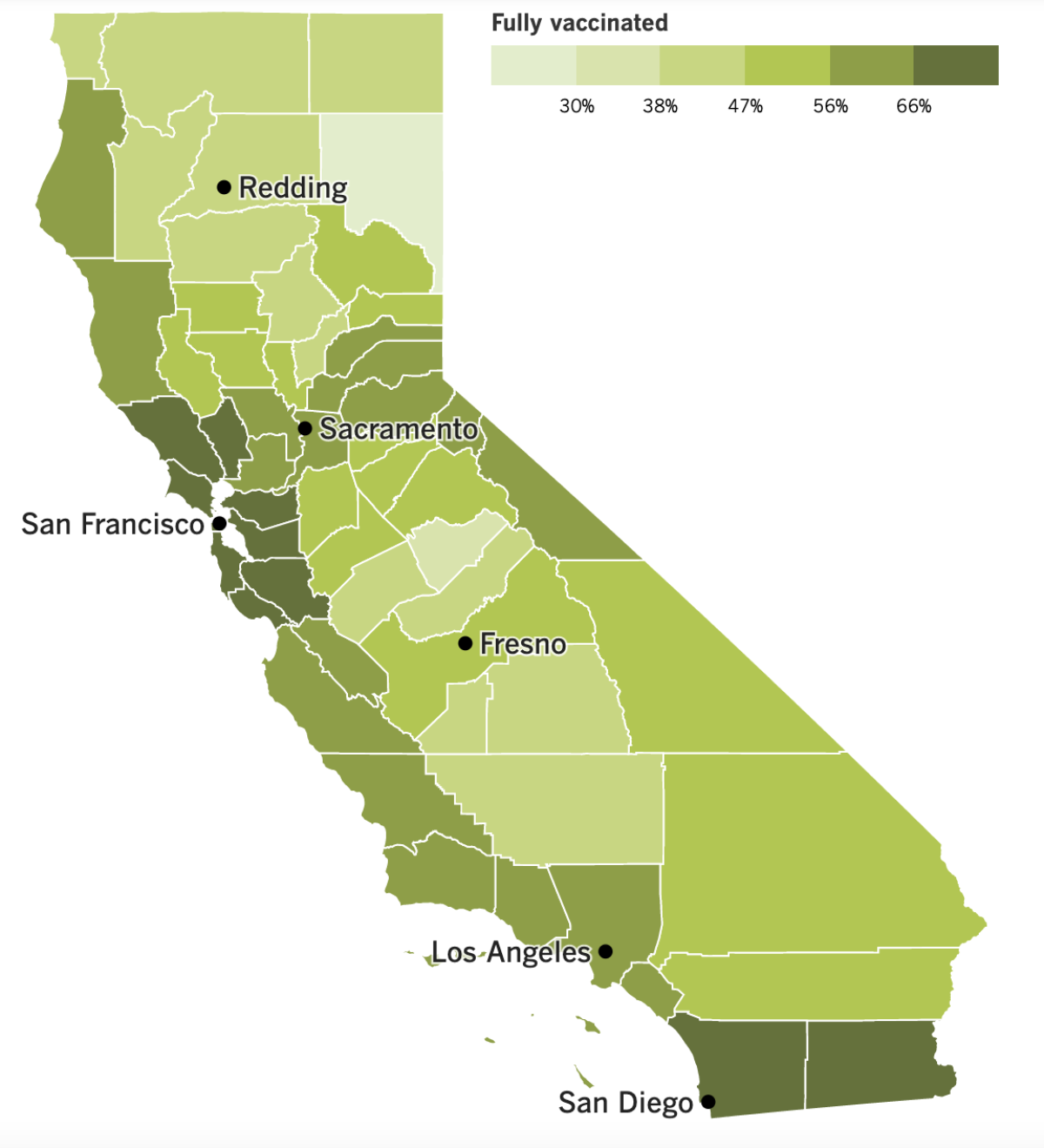Coronavirus Today: The consequences of bucking a vaccine mandate
Good evening. I’m Karen Kaplan, and it’s Tuesday, Nov. 2. Here’s the latest on what’s happening with the coronavirus in California and beyond.
Thousands of people who’ve been told they must get vaccinated against COVID-19 or risk losing their jobs have sworn they will quit before they roll up their sleeves — only to acquiesce as the deadline draws near.
What happens to the tiny minority who don’t back down? My colleague Howard Blume talked to three such employees of the Los Angeles Unified School District to find out. They’re among the roughly 3,700 of the district’s 73,000 employees who remained unvaccinated after the Oct. 15 deadline had passed.
Here are their stories.
Jamal Y. Speakes Sr. is among the 1,325 L.A. Unified employees who have been exempted from the vaccine mandate because of a “sincerely held religious belief.”
In Speakes’ case, that belief is that “my heart, soul and mind belong to the Almighty Creator Elohim,” he said. “It is against my faith and conscience to have any of this injected into my body. I truly believe the God-given immune system has been proven to be the strongest against communicable disease.”
You might think that with a bona fide religious exemption, his work situation would be hunky dory. But you’d be wrong.
The religious exemption means Speakes is still an LAUSD employee. But as long as he’s unvaccinated, the 50-year-old teacher isn’t allowed on campus at Valley Oaks Center for Enriched Studies in Sun Valley. That means he can’t teach the film production classes that are his specialty.
These days, his classes are taught by a substitute who asks students to use the time as a study hall period. Instead of learning behind-the-camera skills, some students work on homework for other classes. Others play with their phones.
Speakes’ new students are paying a price too.
He was reassigned to teach for the City of Angels remote learning program — something he can do because there’s no in-person contact between students and faculty. Instead of film production, he’s now responsible for AP calculus, AP U.S. history, government, health, biology, PE and chemistry — and he’s the first to admit he’s not qualified to teach them.
“What if a student has a question or is special needs and needs help with [calculus], or chemistry?” Speakes said. “They won’t be able to get answers or help from me, who is supposed to be their teacher.”

Hovik Saponghian also got a religious exemption. But he is a teaching assistant, a job that can only be done in person. And since he’s not vaccinated, he can no longer work at Saticoy Elementary School in Sun Valley.
Nor is he likely to find a position anywhere else within L.A. Unified. His last day on the payroll was Oct. 31. Now on unpaid status, he can try to make ends meet working elsewhere and hope to return to Saticoy next school year if the pandemic is over by then and the vaccine mandate is dropped.
“The idea of being careful of what I put in my body and having the ability to decide what I should do is something that I believe applies to everyone whether you are religious or not,” Saponghian said.
Angela Karapetyan has already been fired from her job as a math teacher at Granada Hills Charter over her refusal to get vaccinated. The board of the charter school was not moved by her offer to take daily coronavirus tests — at her own expense — and wear two masks at all times.
Karapetyan and her husband have both had COVID-19. Her case was mild, but her husband became so ill he had to be hospitalized. The way she sees it, her experience buttresses her argument against the vaccine.
“There’s a reason I survived COVID,” she said. ”There’s a reason why God wants me here. I can’t go with this vaccine and neither will my family.”
Karapetyan has been teaching for 18 years and says it’s “what I’ve loved to do all my life.” She may become a full-time teacher to her 11-year-old son and 13-year-old daughter, since she plans to pull them out of school when the district’s vaccine mandate for students kicks in.
By the numbers
California cases and deaths as of 4:25 p.m. Tuesday:

Track California’s coronavirus spread and vaccination efforts — including the latest numbers and how they break down — with our graphics.
How Facebook friended anti-vaxxers
Facebook didn’t create the anti-vax movement. But when its adherents used the humungous social media platform to amplify its opposition to COVID-19 vaccines, Facebook leaders were slow to take steps to stop them, according to internal company discussions that were disclosed to the Securities and Exchange Commission.
For instance, Facebook employees figured out that posts containing false or misleading information about the vaccines could be curtailed and replaced with posts from the World Health Organization and other legitimate sources of pandemic information. The company could make this happen by tweaking the way vaccine-related posts were ranked in users’ newsfeeds.
Normally, those rankings are based on “engagement,” a metric that combines the number of likes, dislikes, comments and shares a post receives; the accuracy of the underlying post and the comments responding to it don’t factor in. But when rankings were instead based on their trustworthiness, the amount of dubious content in newsfeeds fell by nearly 12%, and authoritative content from health agencies increased by 8%.
When those results were shared in a memo, employees responded with enthusiasm. “Given these results, I’m assuming we’re hoping to launch ASAP,” one of them wrote.
That assumption was wrong. Some changes weren’t made for a month, and others were shelved altogether.
Another Facebook employee offered an even simpler suggestion for curtailing vaccine misinformation on the site: Temporarily disable comments on posts related to the COVID-19 shots until company researchers came up with an effective way to deal with them.
No action was taken on that proposal either.

It wasn’t that the company didn’t realize it had a problem. Internal research conducted in February found that up to 60% of posts about COVID-19 vaccines were against the vaccines to some degree. But there was no reliable way to flag them, let alone a plan for removing them.
And that was the good part.
“Our ability to detect [vaccine hesitancy] in comments is bad in English — and basically non-existent elsewhere,” according to an internal memo from March 2.
Facebook critics say there was an urgency to act. February and March were the early months of the country’s COVID-19 vaccination campaign. At the time, the shots were mostly limited to healthcare workers, the elderly and people in poor health. But the public was forming opinions about whether to trust the vaccines, which were developed in record time — some of them using mRNA technology that had never before been authorized for use.
A poll conducted in February by the Associated Press-NORC Center for Public Affairs Research found that 1 in 3 Americans were skeptical of the vaccines, with 15% of respondents saying they definitely wouldn’t get the shots and another 17% saying they’d probably pass. (As of Sept. 30, the AP-NORC Center reported that 11% of those polled had no intention of getting vaccinated and 7% probably wouldn’t.)
A Facebook spokeswoman said the company had made “considerable progress ... in promoting reliable information about COVID-19 and expanding our policies to remove more harmful COVID and vaccine misinformation.” It didn’t act faster because it took time to weigh its options and implement changes.
Others have taken a less charitable view. Silicon Valley venture capitalist Roger McNamee, an early investor in Facebook who has become a vocal critic, said the delay suggested the company’s top priority was promoting posts that would keep users engaged with the site, even if doing so would be detrimental to their health.
“These people are selling fear and outrage,” McNamee said. “It is not a fluke. It is a business model.”
Imran Ahmed, chief executive of the Center for Countering Digital Hate, an internet watchdog group, put it more bluntly.
“Facebook has taken decisions which have led to people receiving misinformation which caused them to die,” he said. “At this point, there should be a murder investigation.”
California’s vaccination progress


See the latest on California’s vaccination progress with our tracker.
Your support helps us deliver the news that matters most.
In other news ...
It’s Día de los Muertos, and we can mark the occasion with yet another grim milestone: COVID-19’s global death toll now exceeds 5 million. That threshold was crossed Monday, according to the ongoing tally by Johns Hopkins University.
The disease is less than 2 years old, but it has already become the third-leading cause of death around the world. (Only heart disease and stroke are higher.)
Nearly half of all reported deaths occurred in the United States, the European Union, Britain and Brazil, even though they account for just one-eighth of the world’s population. The U.S. alone has recorded nearly 750,000 COVID-19 casualties, more than any other country.
“What do we have to do to protect ourselves so we don’t get to another 5 million?” asked Dr. Albert Ko, an infectious disease specialist at the Yale School of Public Health.
Here’s one suggestion from the Centers for Disease Control and Prevention: Immunize the nation’s 28 million children ages 5 to 11.
Members of the CDC’s Advisory Committee on Immunization Practices voted unanimously Tuesday to recommend Pfizer and BioNTech’s kid-friendly COVID-19 vaccine for everyone in this younger age group. After discussing the potential for side effects such as myocarditis, committee members said they were confident any problems that might arise would be detected by the safety monitoring systems already in place.
Concerns about side effects were raised last week by a different group of experts that advises the Food and Drug Administration. The kid-sized doses were tested on just a few thousand children — a group large enough to determine the shots were safe and effective but too small to gauge the frequency of serious yet rare adverse effects.
Given the uncertainties and the fact that elementary-school-age children have been the least vulnerable to serious cases of COVID-19, some of the FDA advisors were wary of pressing for universal vaccination in this age group.
The CDC advisors were more focused on the upside of the vaccine and its potential to curtail coronavirus spread, not just among young children but the older people they interact with as well.
Dr. Rochelle Walensky, the CDC director, signed off on the committee’s recommendation hours later. The shots will be made available to California youngsters pending a review by the Western States Scientific Safety Review Workgroup, and vaccinations in younger children are expected to begin here by the end of the week.
Los Angeles County health officials are pushing to get more shots into teenagers after determining that unvaccinated teens are now more likely to test positive for coronavirus infections than unvaccinated adults.
Not only are unvaccinated teens eight times more likely than their vaccinated peers to test positive, but they’re also “important drivers of transmission across our communities,” according to L.A. County Public Health Director Barbara Ferrer.
Now that teens are back in school, participating in extracurricular activities and attending other types of social gatherings, they have more opportunity to catch and spread the virus. Between mid-September and mid-October, the case rate for unvaccinated adolescents ages 12 to 17 was 32% higher than for adults ages 18 to 49 and 28% higher than for unvaccinated adults 50 and older.
The L.A. County Board of Supervisors issued an executive order in August requiring all county employees to be vaccinated against COVID-19 by Oct. 1 unless they received a religious or medical exemption. A month after that deadline, Sheriff Alex Villanueva is blaming the vaccine mandate for a “mass exodus” in his department.
“We are experiencing an increase in unscheduled retirements, worker compensation claims, employees quitting, and a reduction in qualified applicants,” Villanueva said.
As of Friday, 79% of Sheriff’s Department employees had registered their vaccination status, according to a county spokesman. (Among all county employees, the figure is above 90%.)
“I have repeatedly stated the dangers to public safety when 20% to 30% of my workforce is no longer available to provide service,” the sheriff said. He warned that homicide rates in the county would continue to rise while response times increase and patrol services decline.
A spokesman for the county reiterated the importance of COVID-19 vaccinations for public servants. “The vaccination policy is intended to save lives, not to punish employees based on their vaccination status,” he said.
The U.S. military is working out what to do with employees who refuse to get vaccinated or are seeking exemptions to its vaccine mandate. Although vaccination rates in the armed forces are higher than for the public at large, tens of thousands of people on active duty have resisted getting the shots.
The Pentagon says COVID-19 vaccines are necessary to maintain a healthy fighting force, and it wants to make sure military personnel in all branches of the service are treated fairly and equally. Members of the armed forces are already required to get up to 17 immunizations, and those who refuse are subject to penalties.
Exemptions for medical, religious and administrative reasons will be considered on a case-by-case basis. Those who don’t get the COVID-19 shots could find themselves facing transfers, travel restrictions and limits on their deployments. Bonuses may need to be repaid. In some cases, failure to get vaccinated could end their military careers.
Brig. Gen. Darrin Cox, surgeon general at Army Forces Command, said there must be consequences for “continuing to refuse a valid order.”
Moving oversees, Indonesia has become the first country to grant emergency use authorization to Novavax’s COVID-19 vaccine.
The two-dose vaccine is made with lab-grown copies of the spike protein that covers the coronavirus’ surface, and it’s easier to store and transport than some other COVID-19 vaccines.
The company said in June that its vaccine had proved about 90% effective at preventing COVID-19 in a study of nearly 30,000 people. It also worked against variants circulating in those countries at the time, the company said.
And finally, Ed Sheeran is over his coronavirus infection and has been cleared to perform on “Saturday Night Live” this weekend.
In June, the singer-songwriter appeared on “The Late Late Show With James Corden” to sing an updated version of his hit “Shape of You”:
Moderna or Pfizer will do
You’ll be good after jab number two
But wait two weeks for it to take effect
It doesn’t fit the song but it’s important
Your questions answered
Today’s question comes from readers who want to know: Can children get long COVID?
This is something parents may want to consider as they weigh the pros and cons of vaccinating their kids — including children ages 5 to 11 who will soon gain access to Pfizer and BioNTech’s lower-dose vaccine.
The answer to the question is yes, though children are less likely to be affected than adults.
Long COVID is a mysterious condition in which symptoms drag on for weeks or months after a coronavirus infection has cleared. In some cases, a bout with COVID-19 seems to have resolved, only to recur a month or more later. There are even patients who had no COVID-19 symptoms initially but experienced long COVID later.
Like so much about long COVID, it’s unclear how common it is in children. A recent study from Britain found that about one in 24 children and teens had symptoms more than a month after being infected. The most common included fatigue, headaches and loss of smell; coughing, chest pain and brain fog were also reported. In most of these cases, the symptoms resolved within a couple of months.
The CDC adds that sleep problems, muscle and joint pain, and struggles with concentration can also afflict children and adolescents with long COVID.
The American Academy of Pediatrics advises all children and teens who test positive for a coronavirus infection to have at least one checkup after they’ve recovered from their initial symptoms or once their isolation period has ended. Among other things, that visit — either in person or virtual — will give the doctor a chance to evaluate the patient for signs of long COVID.
We want to hear from you. Email us your coronavirus questions, and we’ll do our best to answer them. Wondering if your question’s already been answered? Check out our archive here.
Resources
Need a vaccine? Keep in mind that supplies are limited, and getting one can be a challenge. Sign up for email updates, check your eligibility and, if you’re eligible, make an appointment where you live: City of Los Angeles | Los Angeles County | Kern County | Orange County | Riverside County | San Bernardino County | San Diego County | San Luis Obispo County | Santa Barbara County | Ventura County
Practice social distancing using these tips, and wear a mask or two.
Watch for symptoms such as fever, cough, shortness of breath, chills, shaking with chills, muscle pain, headache, sore throat and loss of taste or smell. Here’s what to look for and when.
Need to get tested? Here’s where you can in L.A. County and around California.
Americans are hurting in many ways. We have advice for helping kids cope, resources for people experiencing domestic abuse and a newsletter to help you make ends meet.
We’ve answered hundreds of readers’ questions. Explore them in our archive here.
For our most up-to-date coverage, visit our homepage and our Health section, get our breaking news alerts, and follow us on Twitter and Instagram.




